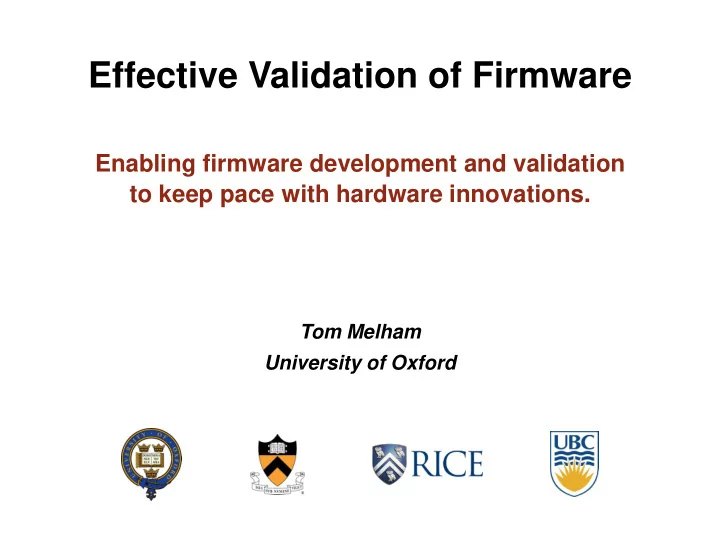

Effective Validation of Firmware Enabling firmware development and validation to keep pace with hardware innovations. Tom Melham University of Oxford
Problem Firmware today • facing greater complexity and shorter schedules • coded at low level, including inline assembly • gated by HW development Current testing-based approaches inadequate • need both HW and SW models • debugging difficult The problem is growing – need some new ideas. 2
Attack Objectives • enable much earlier development and validation • better, faster debugging - through automated analysis • higher productivity - by raising abstraction level Critical-mass effort by a top-class team, balancing • near-term, immediately applicable tools and results • transformative, ambitious, revolutionary research Five-year effort funded by Intel ARO + public funds. 3
Key Ideas Specifically target low-level firmware Joint HW/SW modelling in SystemC • for maximum near-term impact • transaction-level approach Modern automated analysis • proven ideas from OS software level of firmware • in parallel pursue: static analysis, dynamic testing, hybrid Raise abstraction level • type-based resource analysis and address safety 4
Tom Melham Oxford A world-class team Daniel Kroening Moshe Vardi Oxford Rice • with full spectrum of HW, SW, and validation expertise • at four top universities • working closely together and a proven track record of delivering innovation to industry. Luke Ong Oxford Alan Hu UBC Sharad Malik 5 Princeton
Hardware FV High level modelling Symbolic simulation SystemC SystemC C Bounded Model Checking Assertion-based FV Decision Procedures High level modelling Intel Mentor Jim Grundy Firmware validation Domain knowledge Program verification Types Semantics Symbolic execution SAT Solvers & Extensions Low-level SW analysis Transaction-Level Models Concurrent SW 6 Embedded SW Timing Analysis
Environment Modelling SystemC bridging model of HW/SW interface • early abstract model of HW, to validate SW • model of SW to check design of HW • breaks sequential dependency A transaction-level model • capture higher-level meaning with coherent ‘ units of work ’ • enable specifications in terms of this meaning How obtained? • legacy designs, data- mining techniques, … 7
TLM: Princeton Model and Language PriM Architecture Architecture Model T Transactions enable: Specification with concurrent “ units of work ” • refinement checks V U does the microarchitecture implement the architecture? • test generation PriM Microarchitecture analysis of high-level cases Microarchitecture Model S 3 T 1 analysis of potential resource conflicts Implementation of “ units • equivalence checking of work ” T 2 M 5 controlled synthesis enables simpler • in space (physical equivalence checking between resources) and microarchitecture and RTL • time (clock cycles) Synthesized RTL M 4 M 5 8
Automated Firmware Analysis Static checkers – analyze code properties without running it • conformance to HW/SW interface • safety properties – e.g. memory safety • quantitative properties – timing, power Technology • symbolic code execution, backed up with SMT • bit-precise semantics for tricky low-level features • inline assembly, interrupts, typecasting Dynamic testing & hybrid methods • leverage TLM for test generation, coverage • derive monitors the HW/SW interface model 9
Symbolic Simulation CBMC – bounded model checking for C code Samsung OneNAND flash controller (Kim et al) • sector translation layer, multi-sector read • deeply nested loops iterating though complex data structure • exhaustive validation that data correctly read 10
Progress is Rapid CBMC (Clarke, Kroening, Yorav - 2003) • pioneered using bit-accurate symbolic execution • completely automatically, for full ANSI C. • scales to a few thousand lines of code. Calysto (Babic, Hu - 2008) • also based on fully automatic, bit-accurate symbolic execution • but with improvements on all levels: preliminary, lightweight static analysis symbolic execution algorithm abstraction/refinement algorithm decision procedure
Languages and Types Raise coding abstraction level of low-level firmware • type checking to establish specific properties • more scalable than e.g. model checking Main target: resource usage analysis, investigating • assembly language with explicit heap operations – size types • stack overflow in interrupt driven systems – types + MC • synchronous cooperative concurrency – resource bounds Address safety and access control • type-enforced freedom from memory races • infer data-flow properties, e.g. memory ordering 12
Formal Analysis of Interrupt-Driven Programs Simple example problem • interrupt handling is governed by a stack discipline. • interrupts can be interrupted - programmer error can allow the stack to grow unchecked. Our approach • typing discipline for a family of generic assembly languages with interrupts (interrupt calculus of Palsberg et al. 2002). • type soundness: well-typed code does not overflow the stack. • model checking + type inference: use pushdown automata model checking to help derive types. Other properties • liveness properties; termination and recurrence. • performance analysis – e.g. avoidance of interrupt storm 13
We Would Value Your Input Insight – characterizing the real issues Industrial challenge problems A steer towards relevant public-domain examples Joint research 14
Recommend
More recommend